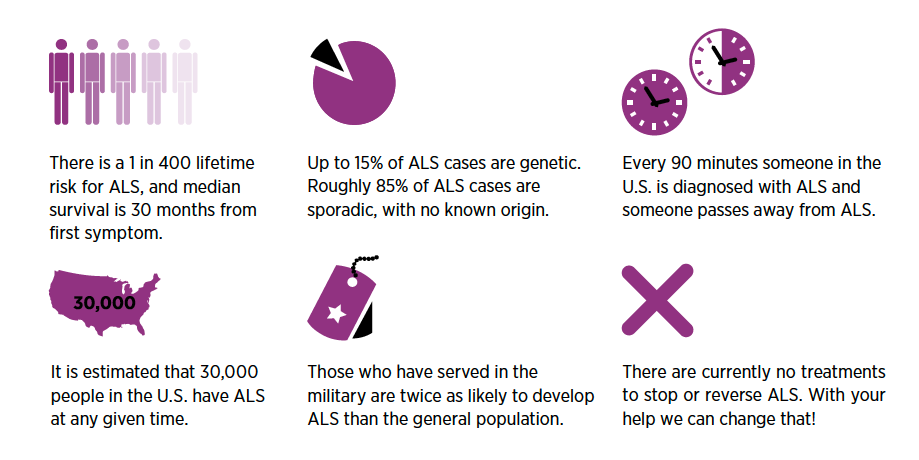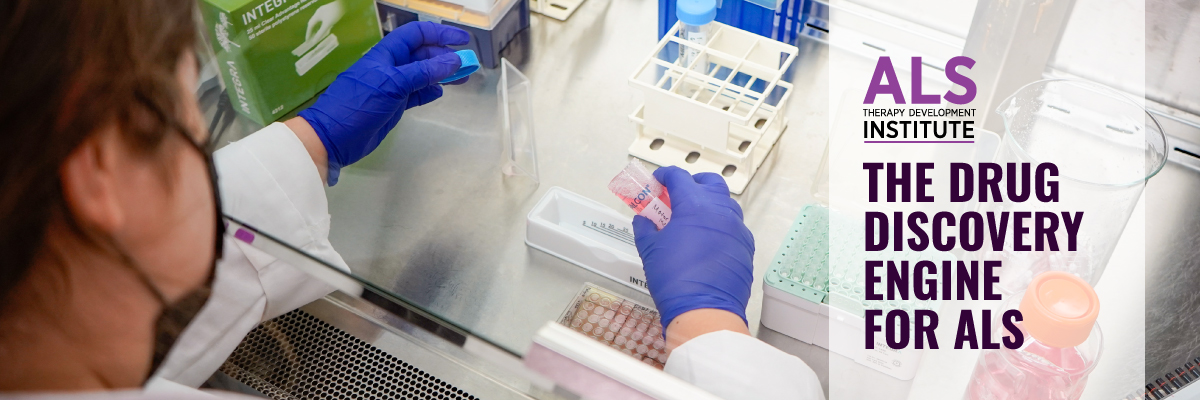Amyotrophic lateral sclerosis (ALS) is a neurological disease of the nerve cells in the brain and spinal cord that control voluntary muscle movement. Also called Lou Gehrig’s disease and motor neuron disease (MND), ALS is caused by progressive deterioration and death of motor neurons, leading to muscle weakness and paralysis.
Facts About ALS

WHY IS ALS SUCH A COMPLEX DISEASE?
ALS can affect anyone of any age, gender or race.
ALS is not experienced in the same way among all diagnosed, and the manner and speed at which the disease moves throughout a person’s body can vary greatly. Median survival for people with ALS is 3-5 years after
they experience their first signs of the disease, but advances in multidisciplinary care may extend survival. The variable rate of disease progression makes prognosis difficult to predict and therapies challenging to develop.
ALS is a complex disease and there is still much that we don’t know. While there are currently no cures or treatments to stop ALS progression, the ALS Therapy Development Institute (ALS TDI) is working hard to
change that.
What Causes ALS?
ALS is caused by progressive deterioration and death of motor neurons, leading to muscle weakness and paralysis. Up to 15 percent of ALS cases have a genetic origin. Genetic ALS can occur in people with or
without a family history of ALS. The remaining cases (roughly 85 percent) are known as sporadic ALS, meaning there is currently an unknown origin for the disease.
Who Gets ALS?
ALS can affect anyone of any age, gender or race. However, for the most part, ALS affects people between the ages of 40 and 70. ALS appears to affect men at a higher rate than women below the ages of 65. Over
the age of 70, incidence appears to be the same.
What are the Symptoms of ALS?
Most people with ALS first feel weakness, muscle cramps, spasms or twitching in one of their arms or legs. This form of the disease is called limb-onset ALS. About 25 percent of people with ALS first have trouble talking clearly and begin to slur their words. This form of the disease is called bulbar-onset ALS.
As the disease spreads, many muscles weaken and start to stiffen and a person with ALS’s breathing may become affected. As the disease progresses and a person’s muscles become paralyzed, they may lose the
ability to move and speak.
How is ALS Diagnosed?
There is no single diagnostic tool for ALS. A series of clinical procedures may also be conducted to rule out neurological conditions whose symptoms closely resemble ALS. For this reason, diagnosis can take as long
as 12 to 14 months in some cases, or even longer.
Are There Treatments for ALS?
There are currently no treatments to stop or reverse ALS progression, but scientists at the ALS Therapy Development Institute (ALS TDI), and organizations around the world, are working hard to develop therapies
for this disease. Today there are dozens of potential treatments in clinical trial globally that are enrolling people with ALS, and there is now also a focus on finding ways to prevent the onset of symptoms.
To learn more about ALS, visit www.als.net/what-is-als.
Help Us End ALS
Our lab at the ALS Therapy Development Institute (ALS TDI) is funded by the ALS community. When you support ALS TDI you are supporting the world’s first and largest nonprofit biotech focused solely on discovering treatments for everyone with ALS.
ALS is not incurable, it is underfunded, and we need your help to end ALS. To donate, visit www.als.net/donate.
